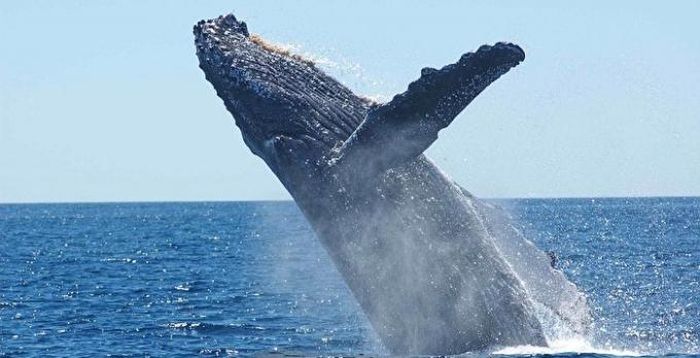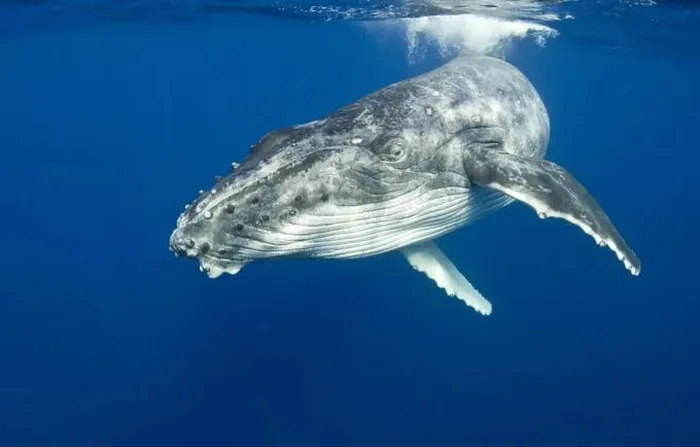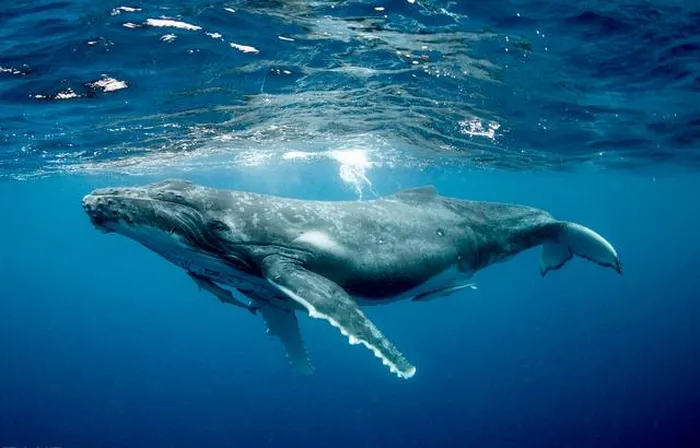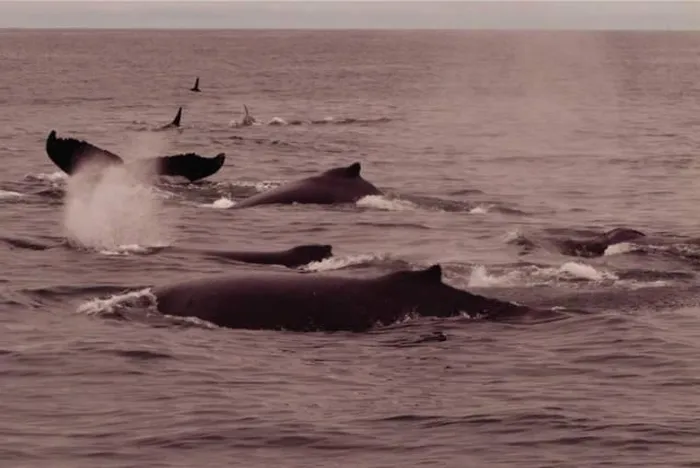What is the feud between humpback whales and killer whales? Why does this huge animal like to cause trouble for killer whales?
Humpback whales ( scientific name : Megaptera novaeangliae ) are giant creatures that roam the vast ocean. Adults can be more than ten meters long and weigh nearly 30 tons. Like many members of the baleen whale family, they feed primarily on small crustaceans such as krill.
Looking at these characteristics, you might guess that humpback whales are like kind and generous big guys who don’t have a worry in the world , just enjoying freely roaming the seas and enjoying the passing of time. . However, many cases show that humpback whales are animals that like to “help the weak” – they seem to especially like to “rescue” the prey of killer whales (scientific name: Orcinus orca ).

What is the feud between humpback whales and killer whales? Why does this famous giant and gentle animal want to cause trouble for killer whales?
Robert L. Pitman from the Southwest Fisheries Science Center in California, USA, and his large research team worked together to understand conflicts between humpback whales and killer whales.
Unlike humpback whales, killer whales are fierce carnivores that often move together and pounce on prey like a pack of wolves.
These “hunters” can be divided into two types, one that mainly hunts fish, while the other mainly hunts marine mammals – such as seals, and even large whales. mature.
Pittman and his colleagues compiled a detailed inventory of 115 conflicts between killer whales and humpback whales between 1951 and 2012, using information provided by at least 54 whale recorders. This phenomenon is worldwide, including among expert researchers and whale enthusiasts.
“If you encounter a grievance in the middle of the road, help out”
The research team found that in 95% of humpback whale intervention cases, the targets of killer whale attacks were mammals. They will even come from thousands of meters away to hinder the killer whale’s hunting, and regardless of the killer whale’s prey.
In fact, only 11% of the time, killer whales chase young humpback whales, and in the remaining 89% of cases, killer whales chase seals, sea lions, sunfish, and gray whales. children and other animals.

In 2009, a Type B killer whale (which feeds mainly on fins) attacked a crab-eating seal. A humpback whale intervened.
Witnesses observed a scene like this: “We saw a group of killer whales chasing a gray whale mother and baby (scientific name: Eschrichtius Robustus), then a humpback whale suddenly appeared appeared and roared to call their companions, and four more appeared immediately. The humpback whales worked together to chase away the killer whales, helping the mother and baby gray whale survive.”
In another case, a group of killer whales attempted to separate a gray whale from its mother and then attacked the calf. Two humpback whales rushed out and used their bodies to block the killer whale from reaching the injured calf. In the end, the baby gray whale still died, but the humpback whale remained in the area to prevent killer whales from eating it.
Even more special, a male humpback whale was recorded rescuing a Stellar sea lion (scientific name: Eumetopias jubatus ) in 1988.
In 2003, he fought bravely with a fish. killer elephant to rescue another Stellar sea lion, and was photographed again. Researchers carefully compared the two photos and confirmed the heroic behavior of this humpback whale over the course of 15 years.
Humpback whale: “I’m not targeting anyone”
There are various indications that humpback whales may rely on their keen hearing to detect killer whale hunting behavior and then intervene.
Killer whales that live in the North Pacific and feed on marine mammals tend to be very quiet when tracking their prey.
This may be because their prey has sensitive hearing, but when they lock on to their target and begin to attack, killer whales begin to make sounds. This may be a method of communication between killer whales.
Humpback whales can react to the hunting sounds of killer whales, even charging from a distance of 7.8 km. It appears that humpback whales respond more to the sounds of killer whales than they do to the sounds of their prey.
Therefore, before arriving at the killer whale’s hunting area, the humpback whale probably does not know which animal it is trying to rescue and it may not care.
In fact, humpback whales target not only killer whales but also bellfish (scientific name: Pseudorca crassidens ) and pilot whales (scientific name: Globicephala ).
Someone once observed “five bell whales quietly eating a fish. At this time, a humpback whale suddenly appeared, rushed straight into the middle of them and easily defeated the group of bell whales like a bowling act. The bell whales fled, emitting shrill screams.”

The reason humpback whales “dare to fight” so much may be because they know very well that predators like killer whales are not their opponents.
Even a humpback whale without any accomplices by its side dares to proactively cause trouble for more than 10 killer whales. If encountering a humpback whale without children nearby, a killer whale will not dare to attack.
Adult humpback whales have giant pectoral fins that are 5 meters long, weigh more than a ton, are extremely flexible, and are often “equipped” with many large, sharp barnacles that can cause the opponent’s skin to tear and bleed. damage upon impact.
When faced with killer whales, humpback whales often just wave their pectoral fins and flap their tail fins randomly, but killer whales seem to be well aware of the dire consequences of being collided and choose to keep their distance. way.
So adult humpback whales are essentially invincible when facing killer whales.

Barnacles, when stuck to the fins of humpback whales, become “weapons” that cannot be underestimated.
Intentional behavior or “free time causes trouble”?
However, where does the humpback whale’s habit of “liking to meddle in other people’s affairs” come from? Researchers are still unable to give a definitive answer.
Experts have discovered many cases of killer whales hunting baby humpback whales.
Baby humpback whales are relatively weak and do not have an absolute size advantage over killer whales. Killer whales often try to separate young humpback whales from the adult herd and attack them.
At this time, the mother humpback whale “will carry the baby on her back and head, lifting it out of the water to avoid being attacked.” labour”. If there are many adult humpback whales, they will sometimes surround the calf for protection.
During one conflict, observers saw 15 killer whales surrounding the smaller of three humpback whales. About an hour after the fierce battle began, the two remaining humpback whales “quickly rushed out onto the battlefield and caused the killer whales to flee” .
Where it is possible to understand why humpback whales and killer whales are “at odds with each other”.

In July 2003, 17 killer whales attacked two humpback whales under the protection of the mother humpback whale. Three other humpback whales arrived to chase away the killer whales.
This heroic act requires a lot of time, energy, and even risks injury. But the humpback whales seem to enjoy this.
Regarding this issue, Pitman speculated: Although small herds of humpback whales are often leisurely and like to go to many places, they have very stable breeding areas.
When the baby grows, it will move back to the breeding area where it used to live. Therefore, protecting the calves of other humpback whale species is beneficial for maintaining the stability of breeding waters and creating a basis for their next generation.
As for protecting other species, according to Pittman, they may just be bored. As for humpback whales, they are rarely injured when fighting killer whales anyway, so they don’t mind “spreading intra-species mutual support to other species.” Perhaps this habit is just for entertainment, exercise and challenging survival skills.
We must wait for further research by marine biologists to find the answer.




